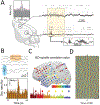Sleep, oscillations, and epilepsy
- PMID: 37226640
- PMCID: PMC10674035
- DOI: 10.1111/epi.17664
Sleep, oscillations, and epilepsy
Abstract
Sleep and wake are defined through physiological and behavioral criteria and can be typically separated into non-rapid eye movement (NREM) sleep stages N1, N2, and N3, rapid eye movement (REM) sleep, and wake. Sleep and wake states are not homogenous in time. Their properties vary during the night and day cycle. Given that brain activity changes as a function of NREM, REM, and wake during the night and day cycle, are seizures more likely to occur during NREM, REM, or wake at a specific time? More generally, what is the relationship between sleep-wake cycles and epilepsy? We will review specific examples from clinical data and results from experimental models, focusing on the diversity and heterogeneity of these relationships. We will use a top-down approach, starting with the general architecture of sleep, followed by oscillatory activities, and ending with ionic correlates selected for illustrative purposes, with respect to seizures and interictal spikes. The picture that emerges is that of complexity; sleep disruption and pathological epileptic activities emerge from reorganized circuits. That different circuit alterations can occur across patients and models may explain why sleep alterations and the timing of seizures during the sleep-wake cycle are patient-specific.
Keywords: REM; interictal; non-REM; ripples; spindle.
© 2023 The Authors. Epilepsia published by Wiley Periodicals LLC on behalf of International League Against Epilepsy.
Conflict of interest statement
None of the authors has any conflict of interest to disclose.
Figures


References
-
- Langdon-Down MRB, W. TIME OF DAY IN RELATION TO CONVULSIONS IN EPILEPSY. The Lancet 1929;213:1029–32.
-
- Karoly PJ, Rao VR, Gregg NM, et al. Cycles in epilepsy. Nat Rev Neurol 2021;17:267–84. - PubMed
-
- Karoly PJ, Freestone DR, Boston R, et al. Interictal spikes and epileptic seizures: their relationship and underlying rhythmicity. Brain 2016;139:1066–78. - PubMed
-
- Baud MO, Ghestem A, Benoliel JJ, et al. Endogenous multidien rhythm of epilepsy in rats. Exp Neurol 2019;315:82–7. - PubMed
Publication types
MeSH terms
Grants and funding
LinkOut - more resources
Full Text Sources
Medical

